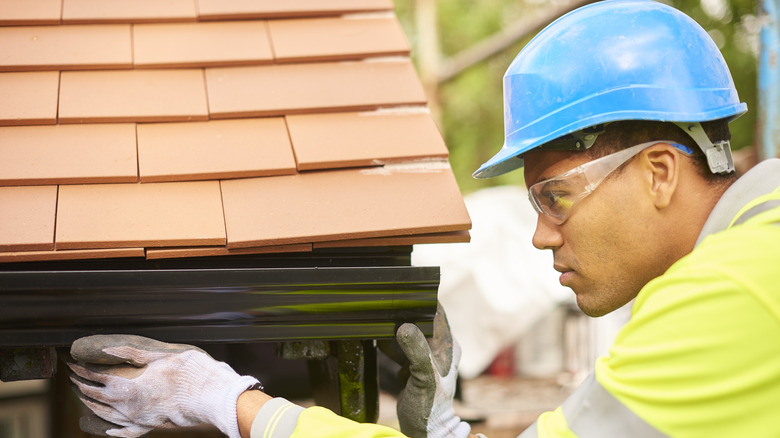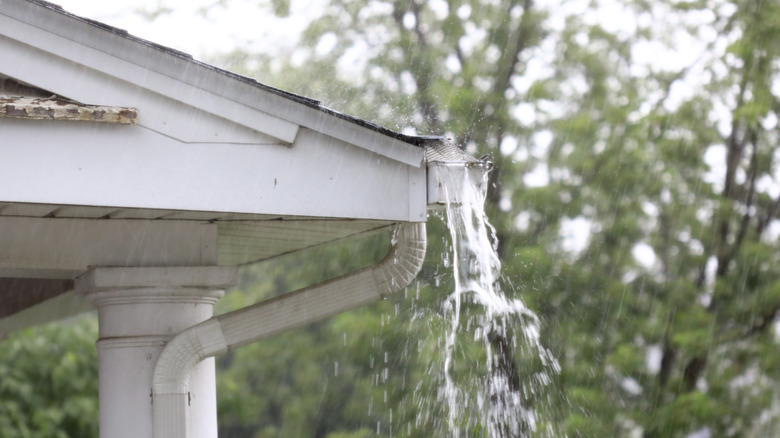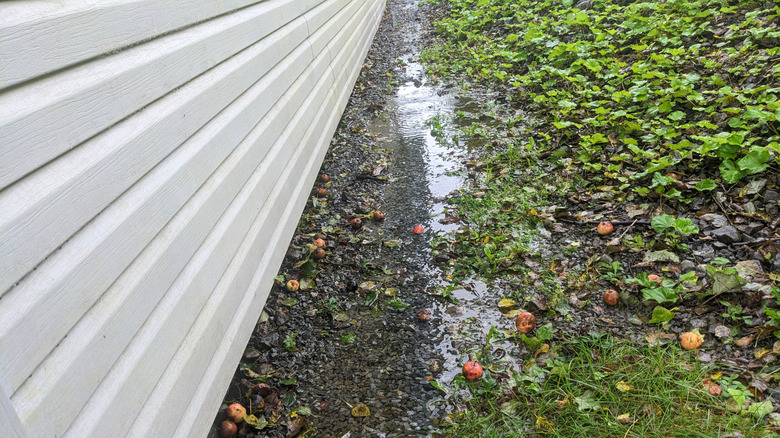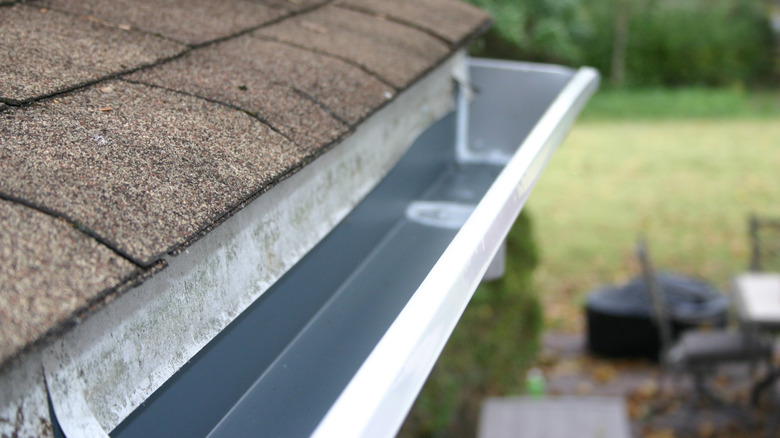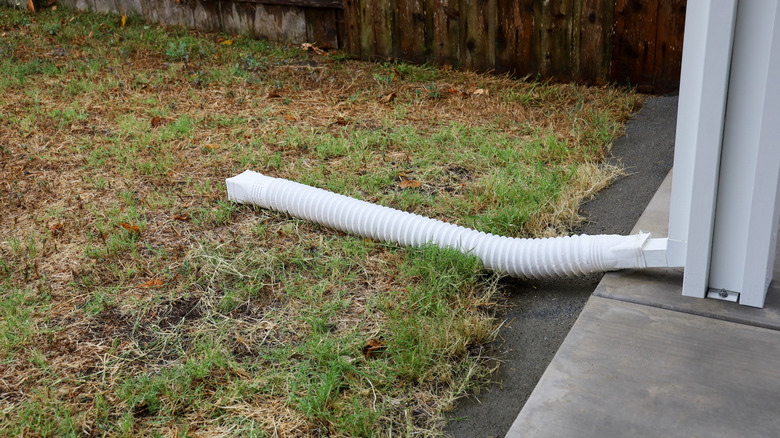How To Tell If Your Gutters Are Installed Wrong (& Tips For Fixing It)
Ever imagined a roof without gutters? You probably haven't, and honestly, you really shouldn't. Without gutters, your house's foundations and the surrounding area are at a massive risk of erosion and long-lasting damage. However, having gutters doesn't necessarily mean you're out of the danger zone. Whether your gutters were DIY installed or handled by a professional, mistakes during installation can result in costly and frustrating damage to your home. Botched installations typically have telltale signs that you could look out for, including gutter leaks and frequently clogged, overflowing, or sagging gutters. Other signs include interior roof leaks, basement and foundation flooding, and an eroding landscape around your home.
When you get clogged gutters, your first thought would probably be dirt buildup. If you clean your gutters at least twice a year but they keep getting clogged, then something fishy might be up. While some factors can cause your gutters to get clogged more often, such as the number of trees around your home or the weather, installation mistakes could cause clogs too. If your gutter size is too small for your roof, you might experience more frequent blockages; gutters should be big enough to let water and any trapped debris flow to the downspout with ease. However, small gutters would barely be able to channel the water fast enough, and the added debris would likely lead to a buildup, then a clog. Also, if the type of gutter in your home is a sectional one, then it could be that one or two of the components in the joints were not installed correctly.
Other tell-tale signs of wrong gutter installations
When it isn't caused by a blockage, overflowing gutters could be a result of installation with a bad pitch or slope. Without enough tilt, you get standing water and overflow at one end of your gutter while the end where the downspout is would have little water flowing to it. If the slope is too steep, water would flow too fast and overwhelm your downspout, causing overflow in that area. Rain gutters that are too small for the home they're installed in can also lead to overflowing gutters.
Now, we know gutters can crack or corrode, which would make them leak. But sometimes, the problem could be because of a badly installed joint. Sectional gutters are connected at different points along the roofline, so they tend to have joints at intervals. If the seals are not installed securely, water can easily leak between the joints. Installing a sectional gutter with so many seams is another mistake because those seams would inevitably leak as well.
Another tell that your gutters might've been installed incorrectly is when you notice them sagging or pulling away from the roof. If your gutter hangers aren't placed at regular intervals, the weight of water would be unevenly distributed, and that strain could cause sagging. Same thing goes for hangers installed with screws that are not the right length. Gutters with a bad pitch or the wrong size can also cause the gutters to collapse under the weight of the excessive water they're forced to carry.
Roof and foundation issues that indicate a botched gutter installation
Hopefully you'd notice other indicators we've mentioned before your wrong installation starts showing more serious signs. If you've experienced pooling water around your home's foundation, interior leaks, roof damage, eroding landscape, or a flooded basement, chances are you have a gutter installation problem.
A wrongly pitched gutter could lead to overflow around your home's foundations and in the surrounding landscape, which can cause water damage in your basement. This could also lead to roof damage as the excess water can cause your roof's fascia to start rotting. Fascia is the part of the roof your gutters attach to and it protects the rafters. A rotting fascia board means increased chances of wall and ceiling leaks, especially in areas near your gutter's location. Another installation mistake that manifests as one or more of these indicators is wrong gutter placement. If gutters are installed too far away from the roofline, rainwater can completely miss them and drip down the back of your gutter and the side of your house.
Downpipes installed in a position that disregards the slope and drainage of your home can also cause foundation or basement flooding and landscape erosion. Additionally, short downpipes would not be able to lead water away from your home, so it can likely keep flowing back to the base of your house, causing more harm than good. An inadequate number of downpipes is another culprit that can cause issues with your home's foundation and landscape.
Fixing installation problems that cause clogged or leaking gutters
For frequent clogs that form because of sectional gutters, the best fix is to install a seamless gutter. Seamless gutters don't have those problematic joints that debris could catch on, so blockages should be infrequent. Since these joints could also cause leaks when they aren't sealed tight, you solve two problems at once when you go for the seamless gutter option. If you don't want to change the gutter entirely, then you have to ensure every component of the joints is installed properly and use the best gutter sealants to keep them leak-proof.
If your gutters clog frequently because they are small, a long-term solution is to get the right size gutter system for your home. Figuring out if your gutters and downspouts are big enough can be a bit tricky, so consider hiring a professional before buying anything. In the short term, you can install gutter guards that keep most of the debris out. However, you should know that small debris, such as pine needles and seed pods, can slip through or accumulate on top of guards, and, if your gutter system is small, it doesn't take long before there's a clog in the gutters or a dam on top of the mesh that leads to more issues. Changing the entire system would actually save you money and time in the long run.
Dealing with other installation errors
Thankfully, for issues caused by incorrect gutter pitch, you don't have to change the entire system. You can repitch the gutters yourself, but we'd advise you to get a professional. Ideally, your gutters should have a ¼-inch slope every 10 feet and be angled towards the downspout. Some DIYers suggest using self-leveling compound to fix this problem, but we do not recommend this. SLC only levels itself, which could eliminate the pitch entirely. Also, the added weight of the compound can cause your gutters to sag. Ensuring you have at least one downpipe every 20 to 40 feet would help reduce cases of overflowing gutters as well as flooding at the base of your home.
To keep your gutters from pulling away from the roof, your hangers have to be installed at the correct intervals. You should have your hangers spaced not more than three feet apart, and that distance reduces to 18 inches in areas with rainy or snowy climates. Screws of about 1.5 inches in length are ideal for most gutter hangers. As always, ensure you follow all the manufacturer's instructions carefully.
Mistakes related to downpipes are usually the cause of water-related issues in your basement, foundations, and surrounding area. For downpipes that are too close to the house, gutter extensions can lead water away from your foundation and landscape. These attachments can even be connected directly to a drain. They should extend your downspout by about 4 to 5 feet and be tilted to face away from the house, taking note of the natural slope of the yard.
